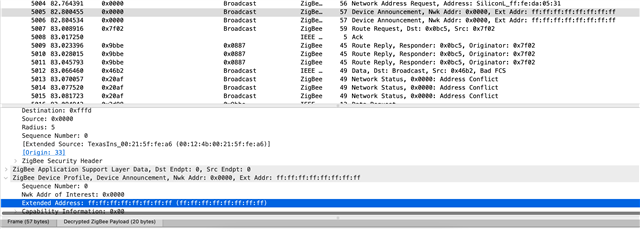Other Parts Discussed in Thread: SYSCONFIG, CC2652R, Z-STACK
A Zigbee2MQTT user with 138 devices on the network is getting NwkTableFull errors (https://github.com/Koenkk/zigbee2mqtt/issues/13180). What table should be increased to prevent this? The firmware is compiled with the following options:
#define MT_SYS_KEY_MANAGEMENT 1
#define FEATURE_NVEXID 1
// Increase frame retries
#define ZMAC_MAX_FRAME_RETRIES 7
#define NWK_MAX_DATA_RETRIES 4
// Increase MAC buffers
#undef MAC_CFG_TX_DATA_MAX
#define MAC_CFG_TX_DATA_MAX 20
#undef MAC_CFG_TX_MAX
#define MAC_CFG_TX_MAX 32
#undef MAC_CFG_RX_MAX
#define MAC_CFG_RX_MAX 20
// Save memory
#undef NWK_MAX_BINDING_ENTRIES
#define NWK_MAX_BINDING_ENTRIES 1
#undef APS_MAX_GROUPS
#define APS_MAX_GROUPS 1
// Increase NV pages to 3 to allow for bigger device tables
#undef NVOCMP_NVPAGES
#define NVOCMP_NVPAGES 3
// Disabling MULTICAST is required in order for proper group support.
// If MULTICAST is not disabled, the group adress is not included in the APS header
#define MULTICAST_ENABLED FALSE
// Increase the max number of boardcasts, the default broadcast delivery time is 3 seconds
// with the value below this will allow for 1 broadcast every 0.15 second
#define MAX_BCAST 30
/**
* Enable MTO routing
*/
#define CONCENTRATOR_ENABLE TRUE
#define CONCENTRATOR_DISCOVERY_TIME 100
#define CONCENTRATOR_ROUTE_CACHE TRUE
#define MAX_RTG_SRC_ENTRIES 255
#define SRC_RTG_EXPIRY_TIME 2
/**
* Scale other device tables appropriately
*/
#define NWK_MAX_DEVICE_LIST 50
#define ZDSECMGR_TC_DEVICE_MAX 200
#define MAX_NEIGHBOR_ENTRIES 20
#define MAX_RTG_ENTRIES 255
/**
* Reduce the APS ack wait duration from 6000 ms to 1000 ms (value * 2 = value in ms).
* This will make requests timeout quicker, in pratice the default timeout of 6000ms is too long.
*/
#define APSC_ACK_WAIT_DURATION_POLLED 500
// From https://www.ti.com/lit/an/swra650b/swra650b.pdf
#define LINK_DOWN_TRIGGER 12
#define NWK_ROUTE_AGE_LIMIT 5
#define DEF_NWK_RADIUS 15
#define DEFAULT_ROUTE_REQUEST_RADIUS 8
#define ZDNWKMGR_MIN_TRANSMISSIONS 0
#define ROUTE_DISCOVERY_TIME 13
#define MTO_RREQ_LIMIT_TIME 5000


